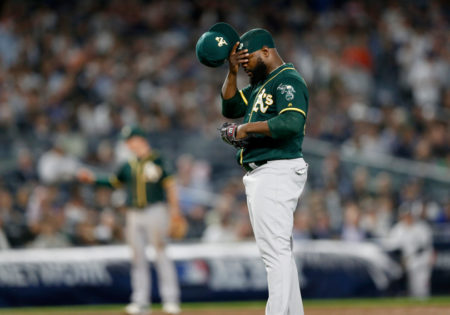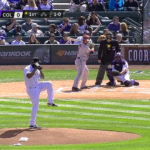Relievers, Wildcards and Apple Pie—Part II
 Part II of a three-part series (see Part I)
Part II of a three-part series (see Part I)
3 Oct 2018: The American League Wild Card Game
The Oakland Athletics started the game with an “opener,” a jittery, twitching right-hander named Liam Hendriks. Amazingly, he had been designated for assignment, unclaimed by any of the other 29 teams, and then sent to the minors in June of this year until he was recalled in September. Perhaps a curious choice for an opener, but then, Oakland probably only wanted one inning from him.
Oakland got less than they bargained for. They quickly fell behind 2-0 in the bottom of the first inning, before they even recorded one out. A walk, and then, BANG.
Aaron Judge walloped a cookie into the left field stands for a two-run homer, and Oakland would never catch up.
Hendricks settled down after a visit from the pitching coach and retired the next three batters.
Lou Trivino followed, and pitched three excellent innings, keeping the score 2-0 until Shawn Kelley pitched a scoreless fifth. The Yankees seemingly were sleep-walking through those four innings. Or was Trivino that good?
Next inning, bottom of the sixth, problems.
Fernando Rodney—once an unhittable shaman on the mound who intimidated hitters as he peered in under his off-center bill before unleashing his array of wicked breaking pitches and dazzling fastballs—stepped on the rubber.
A few pitches later life would no longer be the same for the Athletics in 2018.
Once again Aaron Judge was right in the middle of the tumult. He inside-outed a sliced cue shot that began briefly as a foul ball with such English that it catapulted left into fair territory and just like that sauntered gingerly past the Oakland first baseman, trickling down the right field line for a Little League double.
The next batter, Aaron Hicks, bludgeoned a Rodney off-speed pitch into right-center for a double, scoring Judge, and it was 3-0. A Rodney wild pitch later, Hicks was at third base and Oakland brought the infield in. He threw one ball to Stanton and Bob Melvin came out to the mound, threw out his right arm, and gave it the Oakland twist. Rodney was gone. The new baseball thinking would be on display. Melvin handed his closer Blake Treinen the ball, and plodded back to the dugout.
Perhaps Bob Melvin brought Treinen in because the numbers said he should. Or maybe he realized this was the game. Right here. Right now. However he decided, he brought in his best relief pitcher.
The Oakland closer then walked Giancarlo Stanton (a walk charged to Rodney) and with the infield in, Stanton stole second. Second and third, no one out. Trouble. Where were the strikeouts?
The young, energetic, and innocent Luke Voit strode to home plate.
Until he was acquired at the trade deadline in July from St. Louis, this had been Greg Bird’s place in the lineup. Bird had been anointed the Yankee first baseman for the last few years, but then stopped hitting when he returned from yet another foot injury earlier this year. For several months he looked like a minor leaguer at the plate. And it’s no surprise Bird was not on the roster for the Wild Card game.
His predicament reminded me of the once hyped Nick Johnson who was supposed to be the next great first baseman for the Yankees in the early 2000s, but he could not stay healthy. And ultimately the Yankees found him a new address elsewhere. It would be shocking if Bird was included on the Division Series roster with Boston. It would not be surprising if he were traded during the offseason. Despite Brian Cashman’s oft repeated accolades for the young man who had been hyped to the gills by YES (the Yankees enterainment network). And now was barely mentioned any more. Like Nick Johnson.
Voit took a few fierce swings. Biceps bulging. The sounds of deeply-howled “Lou’s” filled the curvature of the stadium with an infinity of unbridled excitement as he stepped into the box.
Thirteen homers in a few games is a reason for glee. And as he waited for the first pitch, the night sky seemed filled with invisible particles bursting from the electrons and protons that collided, illuminating the outlines of a baseball legend.
Voit dug in, several times. Battled Treinen. On the ninth pitch, a slider on the outer third of the plate, the Yankee first basemen recoiled and drove the ball off the right field wall. It barely escaped the outstretched glove of Stephen Piscotty, who made a valiant effort to catch the line drive before it caromed off the wall like an orb in a squash game. Voit, who had started into his home-run trot, switched gears quickly and motored around to third base. As he slid in, the Yankees were ahead by five.
Didi Gregorious was up next and didn’t waste any time. He lifted a medium fly ball to left field and Voit tagged up. He lumbered toward home plate, contorted his body enough to lunge left of the plate, and reached for the plate with his right hand. He touched home just as the Athletics’ catcher, Jonathan Lucroy, caught the throw and dove toward him in the midst of his gymnastics, ball in glove, and jabbed at Voit’s shoulder. A fine plume of dust sprayed the plate.
A second later the home plate umpire acted out a dramatic safe call, to Lucroy’s chagrin.
The play was reviewed by the umpires, thankfully briefly rather than the long, annoying five minute hiatuses that seem organic at least once or twice every regular season game. And only then was Voit officially declared safe. The score elevating to palpitating 6-0 burden for the Athletics.
Treinen could only watch as runs crossed the plate. He had not put out the fire. Bob Melvin’s idea was to stop the damage using his best weapon. Perhaps it might’ve worked 95 out of 100 times, but on this night it didn’t.
Once the Yankees took command of the game, it no longer mattered that Treinen had been used. The game was effectively lost and there would be no save situation for him later.
Dellin Betances pitched the fifth and sixth innings, and hurled loud, declarative curveballs and pinpoint fastballs, trumpeting that there would be no miracles tonight. Not on his watch. And after his second inning, the sixth, the game was effectively over.
It no longer mattered that Luis Severino, the supposed Yankee ace, had only thrown four innings. Or, looked at another way, as the Yankees’ opener of this game, Severino gave the Yankees four times as much as Hendriks, without surrendering a run. Good work. But the work of an ace?
As mentioned earlier, I vividly remember when Sandy Koufax or Bob Gibson or Tom Seaver would’ve thrown nine innings, a complete game. They would never have considered a four inning outing as a success. And had they received a wild, standing ovation, they might have cringed in embarrassment.
Somehow, we accept mediocrity now. Curtain calls. Why? Incomplete games. Strikeouts. Swinging for the fences. And the little things, the things that makes games great. Too many players don’t execute. Add to that it’s crazy that players don’t bunt against shifts until teams stop shifting. Once or twice a game. Get on base. But many players can’t bunt. Whatever happened to the hit and run?
But this is baseball today. America today. The currency is inflated. There’s a willingness to accept much less than years ago. Even the way we talk about things. ARod. KRod. Cargo. Whatever happened to complete names? Is it that hard to say Carlos Gonzalez? Yes, it’s now almost an impossibility to for a starter to complete a game. So why anoint an ace an ace after a four-inning outing? Just don’t try to convince me that four innings is the work of an ace. It’s not even half a game.
Truth is, there are only a handful of great pitchers in baseball anymore. Great pitchers are a dying breed. Like lions and tigers whose territory is shrinking to the point of irrelevance. And teams that have an ace, should be in the playoffs.
Back to Severino, while he might be hailed as an ace, the jury is still out on his credentials.

























